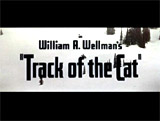
|
Track of the Cat (1954)
In William A. Wellman's unusual, strange and existential
dark western based on Walter Van Tilburg Clark's novel - set in the
1880s in a remote mountainous region of N. California - and a film
that was noted for being shot in Cinemascopic color with mostly stark
black, white, and gray images:
- the dysfunctional and tense wilderness Bridges family
with poisonous relationships between everyone, led by defeated,
patriarchal drunk Pa Bridges (Philip Tonge), and bitter, cold-hearted,
domineering, Puritanical Bible-quoting, rigid matriarch Ma Bridges
(Beulah Bondi) - the children included eldest sensitive, poetry
and nature-loving son Arthur (William Hoppe), rough-hewn, bullying
yet favored 37 year-old son Curt (Robert Mitchum), shy and cowed,
intellectual, indecisive youngest son Harold or "Hal" (Tab
Hunter), and lonely unmarried daughter Grace (Teresa Wright) -
in addition, there was the family's superstitious hired hand -
Joe Sam (the Little Rascals' Carl 'Alfalfa' Switzer), an ancient
and mysterious native American who foresaw the annual appearance
of the cat
- Harold's relationship with his fiancee - pretty neighbor
farm-girl Gwen (Diana Lynn), who was semi-despised by the family
- the legendary "cat" who appeared at the
time of the first snow - a feared, livestock-killing mountain lion/cougar
(or black
"painter"-panther unseen in the film but often heard) reknowned
in Indian lore as a vengeful evil spirit
- the metaphoric stalking and hunting of the animal
by Curt (in a bright red coat), when Arthur was killed by the "black
painter" and Curt (after switching coats with Arthur), returned
his brother's corpse on the back of a horse that knew its way home
- the burial scene of Arthur at the ranch - and the
POV low-angle shot from inside the rectangular grave as the coffin
was lowered into the ground, and mourning Ma's regretful words about
him: "Amen. Can't preach no proper sermon. Don't see much use
if I could. He was a hard one to know. Even if I could make out clear
every last thing about him, body and soul, and had words to tell.
Don't know as it would help. If the Lord won't judge him, surely
ain't my place to judge. He was a good man, like he was a good boy.
Not a mean streak in him. All the things I could say, it seems to
me I could have said 'em when he was alive" - at the climax
of her words, Harold drove a small cross into place under the grey
sky
- the last few moments of Curt's life (now wearing
Arthur's black and white coat) when he found Arthur's poetry book
in the pocket - with a quote from one of John Keats' poems - causing
him panic: "When I had fears that I may cease to be..."
- his own epitaph; shortly later, he attempted (with his last match)
to burn the pages of the poetry book, using it as fuel to avoid freezing
to death - he spitefully thanked his brother: "The only time any
good ever came from your moanin', boy"; after a failed attempt
and in a disoriented and fearful state, Curt ran down a lengthy snowy
slope and over a cliffside to his death
- in the film's conclusion, Joe Sam and Harold located
Curt's body, and the cat was shot and killed by an emboldened Harold;
with cryptic words, Joe Sam declared an end to the family's troubles
if Harold would get married: "Curt not kill, you kill. Him devil...No,
not black, black painter, whole world...You get married, huh?...She
marry, no more trouble. You boss man now!"; the two returned
home - guided by the sight of the family's bonfire built collaboratively,
and Harold was the new, more mature head of the more-unified family
|
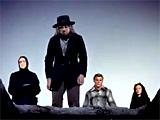
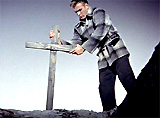
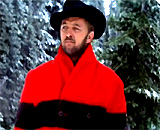
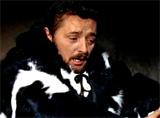
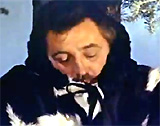
|






